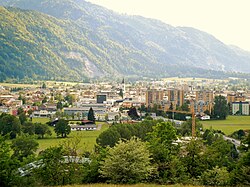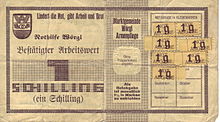Wörgl
Wörgl | |
|---|---|
 Wörgl seen from the east (Grattenbergl) | |
 Location within Kufstein district | |
| Coordinates: 47°29′N 12°04′E / 47.483°N 12.067°E | |
| Country | Austria |
| State | Tyrol |
| District | Kufstein |
| Government | |
| • Mayor | Michael Riedhart |
| Area | |
• Total | 19.74 km2 (7.62 sq mi) |
| Elevation | 511 m (1,677 ft) |
| Population (2018-01-01)[2] | |
• Total | 13,811 |
| • Density | 700/km2 (1,800/sq mi) |
| Time zone | UTC+1 (CET) |
| • Summer (DST) | UTC+2 (CEST) |
| Postal code | 6300-6302 |
| Area code | 043-5332 |
| Vehicle registration | KU |
| Website | www.woergl.at |
Wörgl (German pronunciation: [ˈvœrɡəl]) is a city in the Austrian state of Tyrol, in the Kufstein district. It is 20 km (12 mi) from the international border with Bavaria, Germany.
Population
[edit]| Year | Pop. | ±% |
|---|---|---|
| 1869 | 1,080 | — |
| 1880 | 1,485 | +37.5% |
| 1890 | 2,319 | +56.2% |
| 1900 | 3,126 | +34.8% |
| 1910 | 4,232 | +35.4% |
| 1923 | 4,155 | −1.8% |
| 1934 | 4,196 | +1.0% |
| 1939 | 4,689 | +11.7% |
| 1951 | 6,247 | +33.2% |
| 1961 | 6,828 | +9.3% |
| 1971 | 7,937 | +16.2% |
| 1981 | 8,598 | +8.3% |
| 1991 | 10,041 | +16.8% |
| 2001 | 10,885 | +8.4% |
| 2011 | 12,645 | +16.2% |
Transport
[edit]Wörgl is a railway junction in the line between Innsbruck and Munich, as well as the inner-Austrian line to Salzburg. Its railway station has been designated as a Hauptbahnhof (German: main station) since 10 December 2006.
European route E641 connects Wörgl with Salzburg. The E45 and E60 routes (Austrian autobahn A12) pass through Wörgl.
-
Wörgl railway station in 1900
-
Wörgl railway station in 1965
History
[edit]World War II
[edit]This section needs additional citations for verification. (November 2023) |
The near Itter Castle was the site of one of the last European battles of World War II.[citation needed] The Battle for Itter Castle took place on 5 May 1945, with surrendered Wehrmacht troops, the United States Army, Austrian Resistance fighters and former French political prisoners fighting against the 17th Waffen-SS Panzer Grenadier Division. The leader of the surrendered Wehrmacht troops, Major Josef Gangl, was killed during the battle and is buried in Wörgl's municipal cemetery.[citation needed] Sepp Gangl-Straße is a street in Wörgl named after Gangl.[3]
The Wörgl Experiment
[edit]
Wörgl was the site of the "Miracle of Wörgl", beginning on 31 July 1932 during the Great Depression. Beginning with the issuing of "Certified Compensation Bills", a form of local currency commonly known as Stamp Scrip or Freigeld. This was an application of the monetary theories of the economist Silvio Gesell by the town's then-mayor, Michael Unterguggenberger.
The experiment resulted in a growth of employment and meant that local government projects such as new houses, a reservoir, a ski jump and a bridge could all be completed, contrasting with much of the depression in the rest of the country. Inflation and deflation are also reputed to have been non-existent for the duration of the experiment.[citation needed]
Despite attracting great interest at the time, including from French Premier Edouard Daladier and economist Irving Fisher,[4] the "experiment" was ended by Austria's central bank Oesterreichische Nationalbank on 1 September 1933.[5][6]
British economist John Maynard Keynes thought that "future economics will learn more from Gesell's ideas than from Marx's".[7]
In 2006, milestones were placed across the town to commemorate this event.[8]
Twin towns – sister cities
[edit] Albrechtice nad Orlicí, Czech Republic
Albrechtice nad Orlicí, Czech Republic Suwa, Japan
Suwa, Japan
Notable people
[edit]- Reinhard Furrer, German scientist.
- Gerhard Berger, Former Formula One racing driver and former co-owner of Scuderia Toro Rosso.
- Stefan Horngacher, Olympic ski jumper.
- Hans Peter Haselsteiner, Building tycoon and former deputy chair of the Liberal Forum.
- Richard Kitzbichler, Former Austria national football team player and present assistant manager of Premier League side Southampton F.C.
- Hannes Staudinger, Austrian cinematographer.
- Gisela Wurm, Austrian politician.
Gallery
[edit]
See also
[edit]References
[edit]- ^ "Dauersiedlungsraum der Gemeinden Politischen Bezirke und Bundesländer - Gebietsstand 1.1.2018". Statistics Austria. Retrieved 10 March 2019.
- ^ "Einwohnerzahl 1.1.2018 nach Gemeinden mit Status, Gebietsstand 1.1.2018". Statistics Austria. Retrieved 9 March 2019.
- ^ "Sepp-Gangl-Straße – Heimat Wörgl". heimat.woergl.at. Retrieved 10 January 2024.
- ^ Working for Irving Fischer cato.org Retrieved 18 June 2023
- ^ Boyle, David (2002). The Money Changers: Currency Reform from Aristotle to E-cash. Earthscan. ISBN 978-1-85383-895-8.
- ^ Helleiner, Eric; Helleiner, Faculty of Arts Chair in International Political Economy Professor Eric (2003). The Making of National Money: Territorial Currencies in Historical Perspective. Cornell University Press. ISBN 978-0-8014-4049-6.
- ^ Felber, Christian (2010). Gemeinwohl-Ökonomie [Economy for the Common Good] (in German). ISBN 978-3-552-06137-8.
- ^ "Meilensteine - home". meilensteine.woergl.at.





